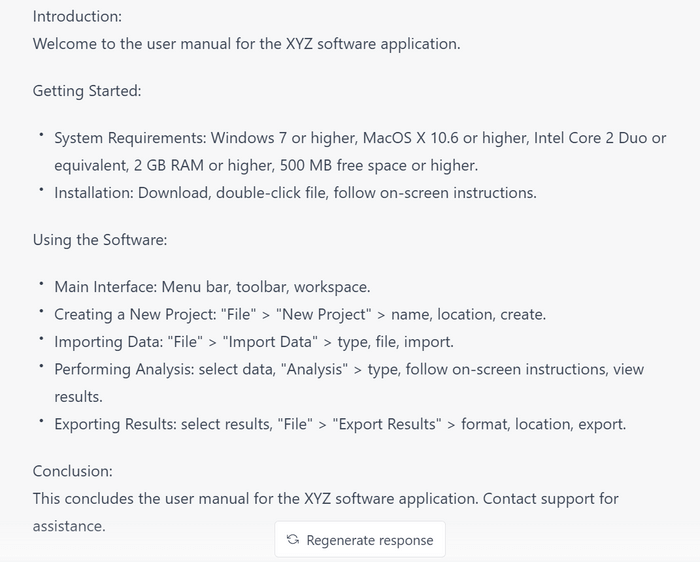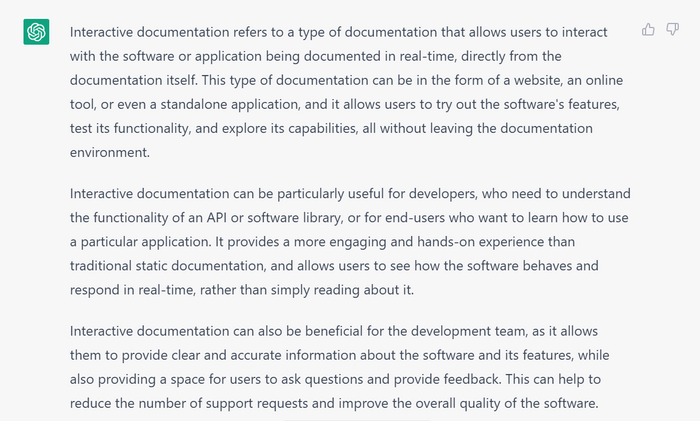ChatGPT for Technical Writing Purposes
 Elmirain Technology on 2/15/2023 — 5 minute read
Elmirain Technology on 2/15/2023 — 5 minute read Elmirain Technology on 2/15/2023 — 5 minute read
Elmirain Technology on 2/15/2023 — 5 minute read

The tech industry is constantly evolving, so it’s important to stay up-to-date with the latest developments and be adaptable and open-minded to new technologies and trends. Today we’re reflecting on ChatGPT by OpenAI. This revolutionary technology is all over the news, so we couldn’t walk on by it and decided to look at it in the context of technical writing.
ChatGPT (Generative Pre-trained Transformer) is a large language model chatbot that interacts in conversational dialogue form. It can provide surprisingly human responses, so you get the feeling of chatting with a real person. ChatGPT was created by San Francisco-based artificial intelligence company OpenAI. The tool is free for all users at the moment. However, as of February 1, there is also a paid subscription version called ChatGPT Plus.
To get started using ChatGPT, you will need to sign up on the official website using your Google account. After that, you will be able to test the tool right away! Get your conversation started by asking a question.
What sets ChatGPT apart from a simple chatbot is that it was specifically trained to understand the human intent in a question and provide helpful and harmless answers. The training was made on massive amounts of data about code and information from the Internet, including sources like Reddit discussions or Twitter databases, to help ChatGPT learn dialogue and attain a human style of responding.
ChatGPT can write code, poems, songs, and even short stories in a specific style. See the fun limerick we asked it to make about ClickHelp:
There was once a tool called ClickHelp,
It made documentation a breeze,
With its features galore,
Tech writers adored,
Creating docs with such ease!
The process of interacting with this tool sometimes feels like the Magic 8 ball moment.
The new AI was created with a focus on ease of use. No wonder it is reaching more than 100 million users in just two months. So what is it that a user can pull off with this tool? Well, the capabilities are the following:

Overall, there are lots of useful features that make this tool great for working on writing projects.
Even though ChatGPT looks awesome, it still has some limitations:
Notwithstanding the limitations, you can still use the tool to create engaging and helpful content.

It’s not a clean slate anymore, and that will do as an outline for your future manual. So you can use ChatGPT to overcome procrastination. Just remember – writing is not just about generating text but also requires skills such as editing, fact-checking, and understanding the audience and purpose of the writing.


ChatGPT can make it simpler and more understandable for an average person.

So condensing lengthy and complicated passages into concise summaries is another way to use ChaGPT.
Though it all sounds great, don’t feel dismayed or threatened by this impressive AI tool. There are things that only a living tech writer can do. For instance, each organization follows its documentation standards. So, whatever content ChatGPT generates should be edited to ensure it follows the organization’s standards and is technically correct, concise, and consistent. And, of course, there will be an ongoing need to maintain the documentation.
Moreover, writing comprises creative art and personal experience that machines may never fully replicate. While AI’s text generation capabilities will keep improving, it will most likely always be viewed as a supplement to human writers rather than a substitute.

When used properly, ChatGPT can be a great tool that can help you with your technical writing and allows you to get your project completed faster without having to spend so much time on it. However, it lacks creativity, emotions, and understanding of the human experience. But it can become a powerful augmentation tool for a writer.
So heave a sigh of relief – tech writers stay on!
Good luck with your technical writing!
ClickHelp Team
Author, host and deliver documentation across platforms and devices
Get monthly digest on technical writing, UX and web design, overviews of useful free resources and much more.
"*" indicates required fields